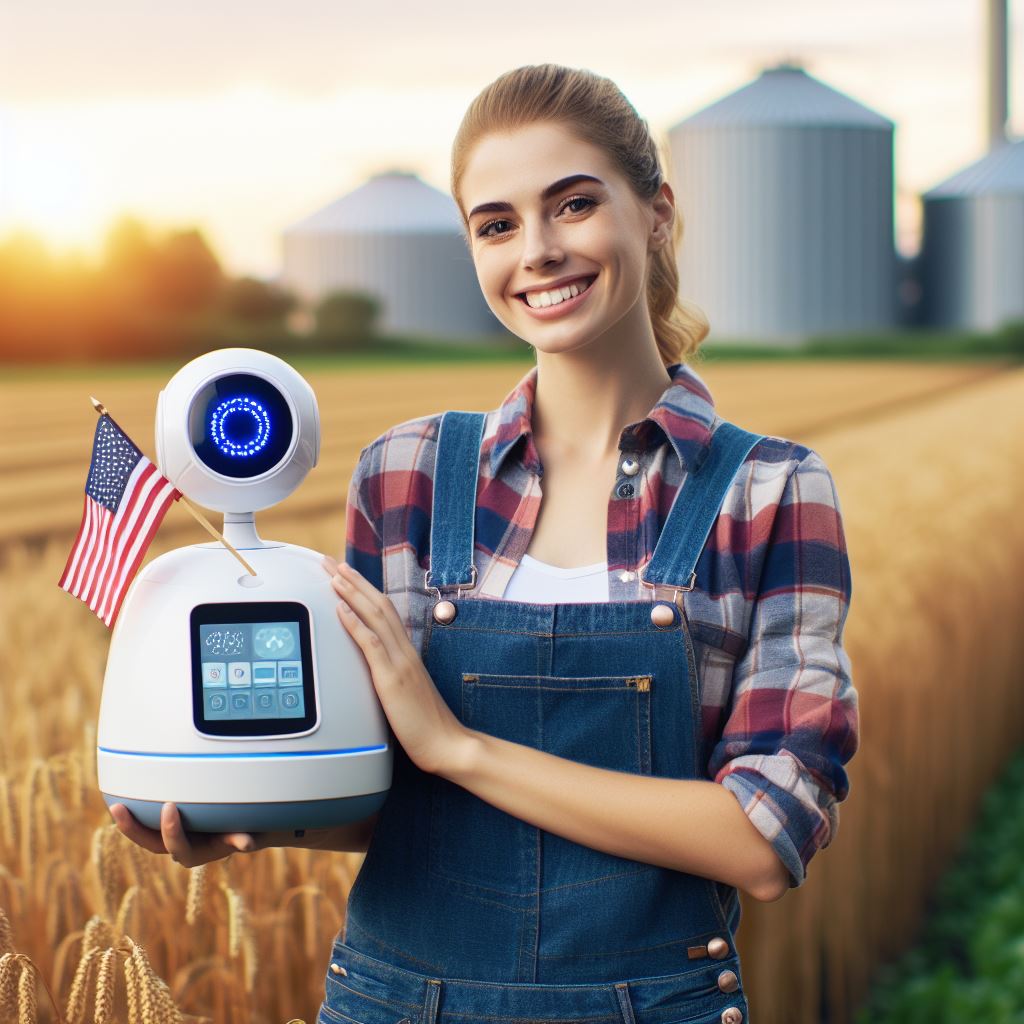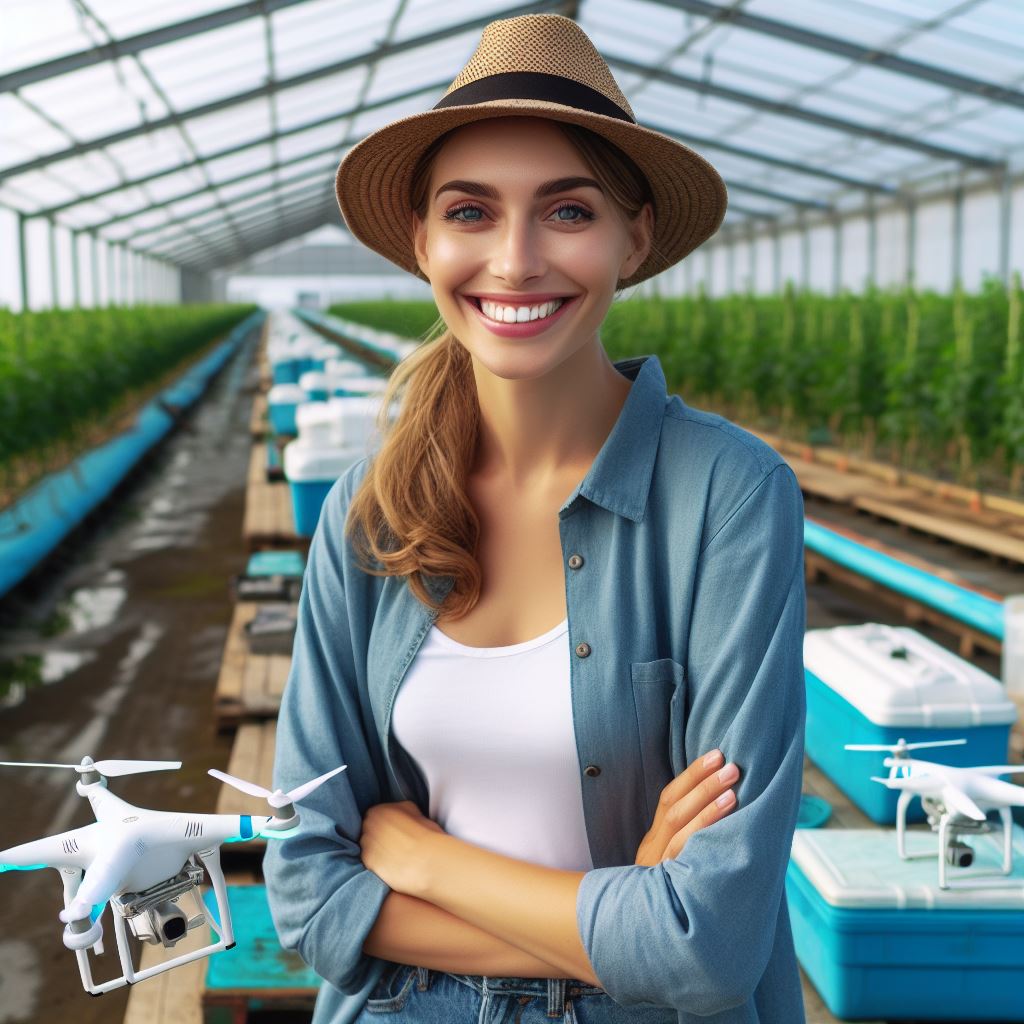Introduction
Precision agriculture, also known as precision farming, revolutionizes traditional farming practices by employing advanced technology for optimized crop management.
In the contemporary agricultural landscape, precision agriculture plays a pivotal role in maximizing productivity, conserving resources, and mitigating environmental impact.
By utilizing data-driven insights and cutting-edge tools such as GPS, drones, and sensors, farmers can precisely tailor their actions to the specific needs of their crops and fields.
This targeted approach enables more efficient use of inputs like water, fertilizers, and pesticides, leading to cost savings and reduced environmental footprint.
Moreover, precision agriculture empowers farmers to make informed decisions in real-time, enhancing overall farm management and profitability.
As the global population continues to grow, the importance of precision agriculture in meeting the increasing demand for food while maintaining sustainability cannot be overstated.
It represents a new era of farming characterized by innovation, efficiency, and environmental stewardship.
Historical context of precision agriculture
Evolution of farming practices
Farming, as an ancient practice, has undergone significant changes throughout history.
Initially, it involved manual labor and simple tools like sticks and stones.
However, with the advent of technologies, farming practices evolved.
Around 10,000 years ago, the Neolithic Revolution marked a crucial turning point in agriculture.
Humans began domesticating plants and animals, transitioning from a nomadic lifestyle to settled farming.
This shift led to the development of more sophisticated farming techniques.
During the Medieval Period, plows and draft animals became widely used, enhancing productivity and efficiency.
As societies expanded, large-scale farming emerged, necessitating advancements in irrigation systems and crop rotation methods.
The 18th and 19th centuries witnessed the Industrial Revolution, which revolutionized agriculture.
Machinery like the seed drill, reaper, and thresher enabled more efficient planting, harvesting, and processing.
These developments increased crop yields and allowed for larger land cultivation.
Emergence and development of precision agriculture technologies
The concept of precision agriculture emerged in the 20th century, driven by technological advancements and the need for sustainable and efficient farming practices.
Precision agriculture refers to the use of technology to gather and analyze data for informed decision-making in farming operations.
In the 1980s, the introduction of GPS technology transformed precision agriculture.
Global Positioning System enabled accurate mapping and spatial data collection, facilitating precise field monitoring and crop management.
Farmers could now precisely locate areas that required specific attention, such as pest control or fertilizer application.
The rapid development of sensors and remote sensing technologies further contributed to the expansion of precision agriculture.
These tools allowed farmers to collect real-time data on soil moisture, temperature, nutrient levels, and crop health.
By analyzing this data, farmers could optimize irrigation, fertilization, and pest control strategies, minimizing waste and improving crop yield.
The utilization of drones in precision agriculture became increasingly prevalent in recent years.
Equipped with high-resolution cameras and sensors, drones provide detailed aerial imagery of farmland.
This allows for early detection of crop diseases, plant stress, and nutrient deficiencies, enabling prompt corrective actions.
Enhancing farming through data and technology
Furthermore, the integration of data analytics and artificial intelligence has enhanced the capabilities of precision agriculture.
By utilizing algorithms and machine learning, farmers can analyze vast amounts of data to gain insights and make informed decisions.
This includes predicting yields, identifying optimal planting areas, and optimizing resource allocation.
Precision agriculture technologies also contribute to environmental sustainability.
With precise data collection and targeted interventions, farmers can minimize the use of fertilizers, pesticides, and herbicides, reducing the environmental impact of agricultural practices.
Additionally, precision agriculture aids in water conservation, efficiently managing irrigation systems to prevent water waste.
In short, the historical context of precision agriculture showcases the evolution of farming practices from simple manual labor to technologically advanced methods.
The emergence and development of precision agriculture technologies, such as GPS, sensors, drones, and data analytics, have revolutionized farming by enabling informed decision-making, optimizing resource allocation, and promoting environmental sustainability.
As we enter a new era of farming, precision agriculture promises increased productivity and efficiency, ensuring a sustainable future for agriculture.
Read: Tech Trends: AI & Crop Management
Key components of precision agriculture
Precision Agriculture is a revolutionary approach to farming that utilizes advanced technologies and data analysis to enhance efficiency and productivity.
Several key components make up the foundation of precision agriculture, including:
Transform Your Agribusiness
Unlock your farm's potential with expert advice tailored to your needs. Get actionable steps that drive real results.
Get StartedGlobal Positioning System (GPS) and Geographic Information System (GIS)
- GPS enables farmers to locate precise positions within their fields, allowing for accurate mapping and analysis.
- GIS integrates GPS data with other relevant information, such as soil and weather data, to generate valuable insights.
- These systems help farmers make data-driven decisions, optimize resource allocation, and ensure better crop management.
Remote sensing and imaging technologies
- Remote sensing involves using sensors and drones to gather valuable data about crop health, moisture levels, and other critical factors.
- Imaging technologies, such as satellite imagery and infrared cameras, provide high-resolution images for detailed analysis of crop conditions.
- These technologies help farmers monitor crop growth, detect pests and diseases, and identify areas requiring specific interventions.
Data collection and analysis tools
- Data collection tools, like sensors and IoT devices, are used to capture real-time information about soil moisture, temperature, and nutrient levels.
- Data analysis platforms process the collected data, allowing farmers to gain valuable insights into crop performance and make informed decisions.
- Analytics tools and machine learning algorithms further assist in predicting crop yield, optimizing irrigation schedules, and minimizing resource wastage.
Automation and robotics in farming operations
- Automation technologies, such as autonomous tractors and drones, enable precise application of fertilizers, pesticides, and irrigation.
- Robots are employed for various agricultural tasks, including seeding, harvesting, and weed control, improving efficiency and reducing labor costs.
- These advancements help eliminate human errors, minimize crop damage, and enhance overall productivity in farming operations.
In combination, these key components of precision agriculture revolutionize traditional farming practices.
The integration of GPS and GIS provides accurate spatial information, while remote sensing and imaging technologies enable detailed monitoring of crops.
Data collection and analysis tools empower farmers to make data-driven decisions, optimizing resource allocation and enhancing crop management.
Finally, automation and robotics augment efficiency and productivity in farming operations.
Precision agriculture offers numerous benefits, including increased crop yields, reduced costs, minimized environmental impact, and improved sustainability.
By embracing these technological advancements, farmers can overcome challenges such as resource scarcity, weather uncertainty, and changing market demands.
It allows for targeted interventions, precision application of resources, and proactive decision-making, ultimately paving the way for a more resilient and profitable agricultural industry.
Read: Next-Gen Farming: The Role of Drones
Benefits of precision agriculture
Increased productivity and efficiency
- Precision agriculture allows farmers to optimize their use of resources and increase overall productivity.
- By using advanced technologies, farmers can precisely measure and control inputs such as water, fertilizers, and pesticides.
- This targeted approach ensures that crops receive exactly what they need, reducing waste and maximizing yields.
- Furthermore, precision agriculture enables farmers to monitor crop health in real-time and take immediate action in case of issues.
- By detecting problems early, farmers can apply interventions, minimizing crop losses and improving overall efficiency.
Cost reduction
- Precision agriculture helps farmers reduce costs by optimizing the use of inputs.
- By applying inputs only where and when necessary, farmers can lower expenses associated with fertilizers, pesticides, and irrigation.
- Moreover, precision agriculture enables farmers to identify areas of the field with low productivity.
- By focusing resources on these areas, farmers can avoid wasting inputs on areas that will not generate significant returns.
- Reducing input costs contributes to higher profit margins and a more sustainable farming operation.
Environmental sustainability and resource conservation
- Precision agriculture plays a vital role in promoting environmental sustainability and conserving natural resources.
- By precisely applying inputs, farmers can minimize the use of chemicals, reducing the environmental impact of farming.
- Furthermore, precision agriculture helps prevent soil erosion, as farmers can monitor and manage soil moisture levels more effectively.
- By avoiding over-irrigation, farmers can conserve water resources and protect the quality of nearby water bodies.
- In addition, precision agriculture enables farmers to reduce greenhouse gas emissions by optimizing machinery operations.
Improved crop quality and yield predictions
- Precision agriculture allows farmers to closely monitor crops and make data-driven decisions.
- By using sensors and remote imaging technologies, farmers can assess crop health, detect diseases, and determine nutrient deficiencies.
- This enables timely interventions, resulting in improved crop quality and reduced losses.
- Furthermore, precision agriculture combines historical data, sensors, and predictive models to enhance yield predictions.
- By analyzing factors such as weather conditions, soil moisture, and crop growth patterns, farmers can anticipate potential yield variations and adjust their management practices accordingly.
In essence, precision agriculture offers numerous benefits to farmers, including increased productivity and efficiency, cost reduction, environmental sustainability, and improved crop quality and yield predictions.
Read: Drone Imaging in Farms: A New Perspective

Challenges and Limitations of Precision Agriculture
Precision agriculture offers numerous benefits and advancements in farming techniques.
However, like any other technological innovation, it also faces challenges and limitations.
In this section, we will discuss some of the key challenges that precision agriculture encounters.
High Initial Investment Costs
One major hurdle in the adoption of precision agriculture is the high initial investment costs involved.
Farmers need to purchase expensive equipment, such as GPS systems, sensors, drones, and software, which can strain their financial resources.
The cost of implementing precision agriculture technology can be too high for small-scale farmers, posing a significant barrier for widespread adoption.
Limited Accessibility in Developing Regions
Another challenge is the limited accessibility of precision agriculture in developing regions.
These areas often lack the necessary infrastructure, including stable electrical grids and internet connectivity, which are essential for the functioning of advanced precision farming systems.
The lack of infrastructure restricts the application of precision agriculture technologies, keeping these regions behind in terms of agricultural productivity.
Data Management and Privacy Concerns
With the increasing use of digital technology and collection of data in precision agriculture, there are concerns related to data management and privacy.
Farmers need to collect, store, and analyze large volumes of data, including sensitive information.
Ensuring data security and protecting privacy becomes a significant challenge, requiring robust data management practices
and strict adherence to privacy regulations.
Training and Knowledge Gap for Farmers
Implementing precision agriculture successfully relies on the ability of farmers to understand and operate advanced technology.
However, many farmers face a training and knowledge gap when it comes to utilizing these advanced tools effectively.
Lack of technical skills and knowledge about precision agriculture techniques can limit the potential benefits that farmers can derive from this technology, affecting its overall adoption and impact.
To address these challenges and overcome the limitations, various steps can be taken.
- Governments and agricultural organizations can provide financial support, grants, or subsidies to farmers to alleviate the burden of high initial investment costs, especially for small-scale farmers. This assistance can promote a wider adoption of precision agriculture technology.
- Developing regions can focus on improving infrastructure, ensuring reliable electric power supply, and enhancing internet connectivity. These measures will enable farmers in these regions to access and utilize precision agriculture technologies effectively.
- Data management and privacy concerns can be addressed through rigorous security measures, encryption techniques, and regulatory frameworks that govern the collection, storage, and use of agricultural data. Implementing proper data governance standards will build trust among farmers and ensure their data remains safe and confidential.
- The training and knowledge gap can be bridged through education and awareness programs. Farmers should be provided with training and workshops on how to use precision agriculture tools efficiently. Collaborations between agricultural universities, extension services, and technology companies can facilitate knowledge transfer and skill development among farmers.
Overall, while precision agriculture holds great promise for improving farming practices, it also faces several challenges and limitations.
By addressing these challenges and providing the necessary support, precision agriculture can be effectively implemented, leading to increased
yields, cost savings, reduced environmental impact, and sustainable farming practices.
Read: Farming Apps: Top Picks for 2024
Case studies and examples of precision agriculture implementation
Smart irrigation systems
- One case study on precision agriculture implementation is the use of smart irrigation systems.
- These systems use sensors and data analysis to optimize water usage in agricultural fields.
- By monitoring soil moisture levels, weather conditions, and crop water requirements, these systems ensure efficient irrigation.
- Through the use of precision technology, farmers can avoid over- or under-irrigation, saving water and improving crop yields.
- Various companies, like Netafim and CropX, provide smart irrigation solutions that have shown significant results in reducing water consumption.
- In California’s Central Valley, smart irrigation systems have led to water savings of up to 25% in almond orchards.
Variable rate fertilization and pesticide application
- Another example of precision agriculture implementation is the practice of variable rate fertilization and pesticide application.
- Rather than applying a uniform rate of fertilizers or pesticides across the entire field, precision technology allows for site-specific application.
- By using sensors, GPS technology, and data analysis, farmers can determine the varying nutrient and pest requirements of different areas within their fields.
- This targeted approach ensures that resources are applied precisely where and when needed, reducing waste and environmental impact.
- In a study conducted in Iowa, farmers using variable rate fertilization achieved an average cost savings of $10.50 per acre compared to uniform application.
- Similar cost savings and environmental benefits have been observed in variable rate pesticide application, with reductions of up to 40% in chemical usage.
Crop health monitoring through drone technology
- Drone technology is revolutionizing crop health monitoring in precision agriculture.
- By capturing high-resolution aerial images, drones provide valuable data on crop health, growth patterns, and stress levels.
- Using advanced imaging techniques, such as normalized difference vegetation index (NDVI), farmers can assess plant vigor and detect anomalies.
- This enables early detection of pest infestations, diseases, or nutrient deficiencies, allowing for targeted interventions.
- By applying crop inputs only where needed, farmers reduce costs and minimize the use of chemicals, resulting in sustainable farming practices.
- An example of successful drone implementation is seen in Australian vineyards, where drones assisted in detecting grapevine trunk disease early, saving millions of dollars in potential losses.
These case studies and examples demonstrate the effectiveness of precision agriculture in improving farming practices.
Smart irrigation systems, variable rate fertilization, and pesticide application, along with crop health monitoring through drone technology, are just a few of the many applications of precision agriculture.
By harnessing innovative technologies, farmers can optimize resource usage, increase yields, and minimize environmental impact.
The adoption of precision agriculture is essential in addressing the challenges of feeding a growing global population while ensuring sustainability.
Through continued research and development, precision agriculture will continue to evolve and transform the future of farming.
Future prospects and trends in precision agriculture
Precision agriculture has come a long way since its inception, and the future looks even more promising.
As technology continues to advance at a rapid pace, several trends and prospects are set to shape the future of precision agriculture.
Integration of Artificial Intelligence (AI) and Machine Learning (ML)
The integration of AI and ML will revolutionize precision agriculture by enabling smart and autonomous decision-making.
AI algorithms can analyze vast amounts of data collected from sensors, drones, and satellites to provide actionable insights.
Machine learning algorithms are capable of learning from data, enabling dynamic and predictive analysis.
With AI and ML, farmers can optimize resource allocation, crop management, and yield predictions.
These technologies can analyze soil health, weather patterns, pest infestations, and plant diseases to provide real-time recommendations.
The integration of AI and ML will significantly enhance the efficiency and productivity of precision agriculture.
Adoption of Internet of Things (IoT) technologies
The adoption of IoT technologies will further enhance the connectivity and data-driven nature of precision agriculture.
IoT devices, such as soil moisture sensors, weather stations, and livestock trackers, can collect real-time data and transmit it to centralized systems.
These devices will enable farmers to monitor their crops and livestock remotely, optimizing irrigation, fertilization, and animal welfare.
The data collected from IoT devices can be analyzed to identify trends, patterns, and anomalies, providing valuable insights for decision-making.
Furthermore, the integration of IoT with AI and ML will enable autonomous systems that can detect and respond to changing conditions.
For example, irrigation systems can automatically adjust water flow based on real-time weather forecasts.
Collaboration between farmers, researchers, and technology developers
The future of precision agriculture relies heavily on collaboration between different stakeholders.
Farmers, researchers, and technology developers need to work together to exchange knowledge, develop innovative solutions, and overcome challenges.
Showcase Your Farming Business
Publish your professional farming services profile on our blog for a one-time fee of $200 and reach a dedicated audience of farmers and agribusiness owners.
Publish Your ProfileFarmers play a vital role in providing on-ground insights and validating the effectiveness of precision agriculture technologies.
Researchers can contribute by conducting studies, experiments, and field trials to develop new techniques and refine existing ones.
Technology developers need to design user-friendly and cost-effective solutions tailored to the needs of farmers.
They also need to collaborate with farmers to ensure that the technologies are practical, reliable, and easy to integrate into existing farming systems.
Collaboration can also facilitate knowledge sharing and capacity building among stakeholders.
Training programs and workshops can help farmers understand the potential benefits of precision agriculture and learn how to effectively utilize the available technologies.
In general, the future of precision agriculture holds immense opportunities for transforming farming practices.
The integration of AI and ML, adoption of IoT technologies, and collaboration between farmers, researchers, and technology developers will drive innovation and improve the overall efficiency and sustainability of farming.
With these trends and prospects, precision agriculture is poised to revolutionize the agricultural industry and meet the growing demands of the global population.
Conclusion
Recap of the advantages and potential of precision agriculture
Precision agriculture offers numerous benefits to farmers, including increased productivity, decreased costs, and efficient resource utilization.
By leveraging advanced technologies such as GPS, sensors, and data analytics, farmers can accurately monitor and manage their crops, resulting in higher yields and better quality produce.
Encouragement for farmers to embrace precision agriculture practices
It is crucial for farmers to embrace precision agriculture practices to stay competitive in today’s rapidly evolving farming industry.
By adopting these technologies, farmers can optimize their operations, improve decision-making, and maximize their profits.
Moreover, precision agriculture not only benefits individual farmers but also contributes to sustainable farming practices by reducing the environmental impact and conserving resources.
Closing thoughts on the transformative impact of precision agriculture on the farming industry
Precision agriculture is ushering in a new era of farming, revolutionizing traditional practices and unlocking unparalleled opportunities.
This transformative technology has the potential to address the challenges faced by the agriculture sector, such as increasing global food demand, limited resources, and environmental concerns.
By embracing precision agriculture, farmers can secure a sustainable future for themselves and contribute to global food security.




